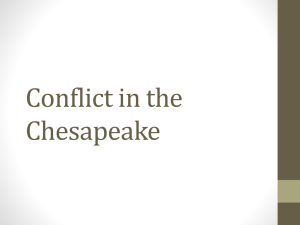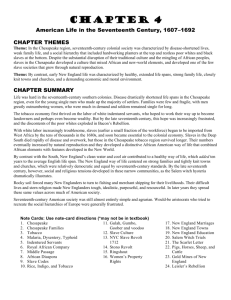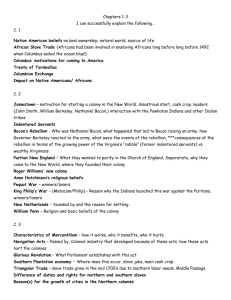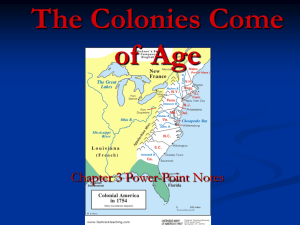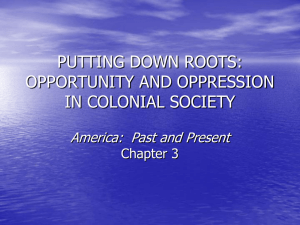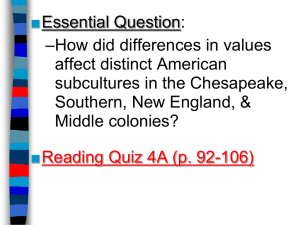chapter 4 - Madison County Schools
advertisement
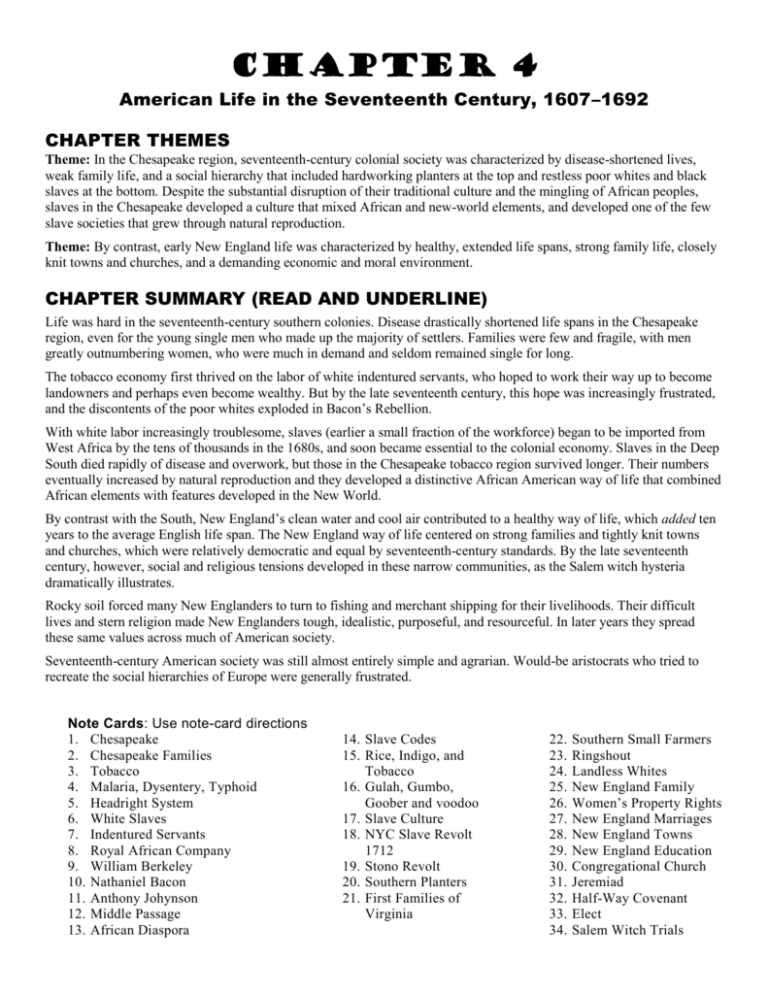
Chapter 4 American Life in the Seventeenth Century, 1607–1692 CHAPTER THEMES Theme: In the Chesapeake region, seventeenth-century colonial society was characterized by disease-shortened lives, weak family life, and a social hierarchy that included hardworking planters at the top and restless poor whites and black slaves at the bottom. Despite the substantial disruption of their traditional culture and the mingling of African peoples, slaves in the Chesapeake developed a culture that mixed African and new-world elements, and developed one of the few slave societies that grew through natural reproduction. Theme: By contrast, early New England life was characterized by healthy, extended life spans, strong family life, closely knit towns and churches, and a demanding economic and moral environment. CHAPTER SUMMARY (READ AND UNDERLINE) Life was hard in the seventeenth-century southern colonies. Disease drastically shortened life spans in the Chesapeake region, even for the young single men who made up the majority of settlers. Families were few and fragile, with men greatly outnumbering women, who were much in demand and seldom remained single for long. The tobacco economy first thrived on the labor of white indentured servants, who hoped to work their way up to become landowners and perhaps even become wealthy. But by the late seventeenth century, this hope was increasingly frustrated, and the discontents of the poor whites exploded in Bacon’s Rebellion. With white labor increasingly troublesome, slaves (earlier a small fraction of the workforce) began to be imported from West Africa by the tens of thousands in the 1680s, and soon became essential to the colonial economy. Slaves in the Deep South died rapidly of disease and overwork, but those in the Chesapeake tobacco region survived longer. Their numbers eventually increased by natural reproduction and they developed a distinctive African American way of life that combined African elements with features developed in the New World. By contrast with the South, New England’s clean water and cool air contributed to a healthy way of life, which added ten years to the average English life span. The New England way of life centered on strong families and tightly knit towns and churches, which were relatively democratic and equal by seventeenth-century standards. By the late seventeenth century, however, social and religious tensions developed in these narrow communities, as the Salem witch hysteria dramatically illustrates. Rocky soil forced many New Englanders to turn to fishing and merchant shipping for their livelihoods. Their difficult lives and stern religion made New Englanders tough, idealistic, purposeful, and resourceful. In later years they spread these same values across much of American society. Seventeenth-century American society was still almost entirely simple and agrarian. Would-be aristocrats who tried to recreate the social hierarchies of Europe were generally frustrated. Note Cards: Use note-card directions 1. Chesapeake 2. Chesapeake Families 3. Tobacco 4. Malaria, Dysentery, Typhoid 5. Headright System 6. White Slaves 7. Indentured Servants 8. Royal African Company 9. William Berkeley 10. Nathaniel Bacon 11. Anthony Johynson 12. Middle Passage 13. African Diaspora 14. Slave Codes 15. Rice, Indigo, and Tobacco 16. Gulah, Gumbo, Goober and voodoo 17. Slave Culture 18. NYC Slave Revolt 1712 19. Stono Revolt 20. Southern Planters 21. First Families of Virginia 22. 23. 24. 25. 26. 27. 28. 29. 30. 31. 32. 33. 34. Southern Small Farmers Ringshout Landless Whites New England Family Women’s Property Rights New England Marriages New England Towns New England Education Congregational Church Jeremiad Half-Way Covenant Elect Salem Witch Trials 35. 36. 37. 38. Midwifery The Scarlet Letter New England Way of Life Pigs, Horses, Sheep, and Cattle 39. Gold Mines of New England 40. Yankee Ingenuity 41. Leisler’s Rebellion Chapter 4 Study Guide Thought Questions/Observations: The Unhealthy Chesapeake 1. "Life in the American wilderness was nasty, brutish, and short for the earliest Chesapeake settlers." Explain. 1a. The Tobacco Economy 2. What conditions in Virginia made the colony right for the importation of indentured servants? 2a. Frustrated Freemen and Bacon's Rebellion 3. Who is most to blame for Bacon's rebellion, the upper class or the lower class? Explain. 3a. Colonial Slavery 4. Describe the slave trade. 4a. Africans in America 5. Describe slave culture and contributions. 5a. Makers of America: From African to African-American 6. "And precisely because of the diversity of African peoples represented in America, the culture that emerged was a uniquely New World creation." Explain. 6a. Southern Society 7. Describe southern culture in the colonial period, noting social classes. 7a. The New England Family 8. What was it like to be a woman in New England? 9. How was family life in New England different from that of the Chesapeake and the South? 8/9a. Life in the New England Towns 10. Explain the significance of New England towns to the culture there. 11. Contrast New England towns with those of more Southern Colonies. 10/11a. The Half-Way Covenant and the Salem Witch Trial 12. What evidence shows that New England was becoming more diverse as the 17th century wore on? 12a. The New England Way of Life 13. How did the environment shape the culture of New England? 13a. The Early Settlers' Days and Ways 14. How much equality was evident in the colonies? 14a. Analysis Questions 1. Why was family life in New England so different from family life in the South? 2. Why did slavery grow to be such an important institution in colonial America? What were the effects of slavery on the Africans who were brought to the New World? What were the effects of the Africans on the New World? 3. What was attractive and unattractive about the closely knit New England way of life? 4. Were the Salem witch trials a peculiar, aberrant moment in an age of superstition, or did they reflect common human psychological and social anxieties that could appear in any age? How harshly should those who prosecuted the “witches” be condemned? 5. Explain the search for a suitable labor supply in the plantation colonies, contrasting the relative advantages and disadvantages of white indentured servants and slaves (from the planters’ point of view). Perhaps use Bacon’s Rebellion as the clearest illustration of why planters feared uncontrolled laborers and turned increasingly to slavery. HISTORIC NOTES Social-class conflict is a key element in the revisionist interpretation of American historical development. Always under the surface of colonial societies, it erupts into full-scale civil war with Bacon’s Rebellion, in VA. The introduction of slavery into the New World transforms the social, economic, and political makeup of the colonies. The primary source of African slaves is west-central Africa. Religious hysteria in the form of witch trials plague the North American colonies, especially in New England settlements. European class-based customs, such as the wearing of fancy jewelry by certain segments of society, do not find fertile ground in the more democratic New World English colonies. Although initially an area where settlement barely survived, the Chesapeake colony region soon spawned a powerful industry: cultivating and selling tobacco. So important was this crop that it helped maintain the economy of the region and, because of its tendency to exhaust the soil, led to westward penetration of the Chesapeake colonies. The social life and customs of the North American colonists were considerably shaped and affected by where they lived. Unique cultural traits took root in the New England, middle, and southern colonies. Despite the presence of slavery in the colonies, white settlers were not so quick to nurture the type of social stratification that prevailed in Europe. Advanced Placement United States History Topic Outline 1. Transatlantic Encounters and Colonial Beginnings, 1492-1690 A. First European contacts with Native Americans B. Spain's empire in North America C. French colonization of Canada D. English settlement of New England, the Mid-Atlantic region, and the South E. From servitude to slavery in the Chesapeake region F. Religious diversity in the American colonies G. Resistance to colonial authority: Bacon's Rebellion, the Glorious Revolution, and the Pueblo Revolt 2. Colonial North America, 1690-1754 A. Population growth and immigration B. C. D. E. F. Transatlantic trade and the growth of seaports The eighteenth-century back country Growth of plantation economies and slave societies The Enlightenment and the Great Awakening Colonial governments and imperial policy in British North America
